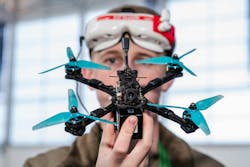Navy researchers ask industry for uncrewed electronic warfare (EW) to disrupt enemy RF communications
CRANE, Ind. – U.S. Navy researchers are asking for industry participation in technology demonstrations of small disposable uncrewed vehicles with electronic warfare (EW) payloads able to destroy or disrupt enemy communications, radar, and surveillance sensors.
Officials of the Naval Surface Warfare Center Crane Division (NSWC Crane) in Crane, Ind., issued a special notice (N0016424SNC23) last week for the Silent Swarm 2025 project.
This project focuses on distributed electromagnetic attack, deception and concealment, digital payload delivery, resilient communications, and EW support with geolocation.
Reconfigurable and networked uncrewed vehicles that fly, move along the ground, or travel over the water should be able to target enemy RF communications; S-band, X-band, and navigation radar; and enemy intelligence surveillance and reconnaissance (ISR) systems.
Related: The sensor- and signal-processing challenges of electronic warfare
The goal is to design distributed capabilities to create chaos and confusion in the RF spectrum by targeting adversary situational awareness, command and control, and decision-making that give friendly forces freedom of maneuver.
Silent Swarm focuses on enabling technologies in the technology readiness level (TRL) 2 to 5 range, which refers to technology concepts to breadboard demonstrations in realistic environments.
Researchers are interested in small unmanned vehicles that can mimic signal of interest; have the ability to overwhelm adversary sensors and decision making; and create an RF congested environment to deny the enemy's ability to maintain an accurate picture of the battlefield.
These uncrewed vehicles and EW payloads should be able to manipulate signals received by target sensors, and deny enemy command and control systems; commercial wireless links; tactical networks; defend and attack resilient tactical communications; and deceive enemy networks.
Uncrewed vehicles and payloads should be anti-jam and low-probability of intercept; multi-channel; involve mesh networks; have adaptive bandwidth control; use adaptive radio control; offer millimeter wave communication networks; use-free space optics; and infrared sensors. Payloads should have narrowband and wideband jammers; and sensing and geolocation capabilities.
Systems should have swarming and intelligent algorithms; alternative position, navigation, and timing; and artificial intelligence and machine learning.
Companies interested should submit unclassified white papers no later than 15 Oct. 2024 to the Vulcan website at https://www.cylitix.com/homepage/about-us/services/innovation-science/vulcan-page/faq-gov202/. Register for Vulcan online at https://vulcan-sof.com/login/ng2/auth/login?requestedUrl=%2Fhome.
Email questions or concerns to the Navy's Robert Gamberg at [email protected] or Michelle Kitley at [email protected]. More information is online at https://sam.gov/opp/a5dd0cb585a24748a96a1adc52ef8006/view.
About the Author
John Keller
Editor-in-Chief
John Keller is the Editor-in-Chief, Military & Aerospace Electronics Magazine--provides extensive coverage and analysis of enabling electronics and optoelectronic technologies in military, space and commercial aviation applications. John has been a member of the Military & Aerospace Electronics staff since 1989 and chief editor since 1995.

